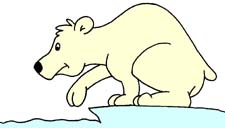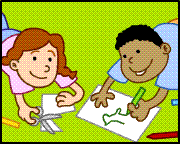|
Volume 6, Issue 1
January 7, 2008
****************************************************************************************
A WORD ABOUT THIS ISSUE'S THEME: ARCTIC ANIMALS
****************************************************************************************
Use our poem to introduce your unit on Arctic Animals, inviting children to find out more about these animals and their adaptations.
 Polar bears Polar bears
Look snowy white.
Arctic hares
Hop out of sight.
Sweet harp seals
Change as they grow.
Snowy owls fly
High then low.
Do they all
Stay snug and warm,
In snow and ice
And winter storms?
Susan LaBella
Editor, Early Childhood Education Newsletter
****************************************************************************************
ACTIVITY IDEAS
****************************************************************************************

BABY BELUGA
Let children listen to and sing along with Raffi's song, Baby Beluga. Explain that this whale swims in the icy cold waters of the Arctic. Then use this opportunity to introduce the word blubber. Explain that blubber is a layer of fat under an animal's skin that keeps beluga whales, polar bears, and other animals warm in below-freezing temperatures. Let a student put one hand in a plastic baggie. Have him/her place that hand into second baggie that has been thickly coated on the inside with Crisco. (The baggie that covers the student's hand will protect the hand from contact with the Crisco.) Then have the student place his or her hand into a bowl of ice water. Let the student place his/her other hand (bare hand) into another bowl of ice water. Ask: How does the hand in the Crisco feel? How does the bare hand feel? Why do you the bare hand feels colder than the baggie-covered hand? Encourage others to try this simple experiment and draw conclusions about the pro tective capacities of blubber.
HOW DO THEY LIVE?
Let children use simple picture books to find out more about Arctic animals such as polar bears, arctic foxes, lemmings, snowy hares, and others. Then together create a class book about an animal. First write sentence frames on an easel pad for children to copy. For example:
Polar bears eat _________.
Polar bears have __________.
When the sentences are complete, have children illustrate their pages and bind them together. Place the book in your book corner for children to share.
REINDEER, REINDEER
Remind children that reindeer are wild animals that live in the Arctic, eating grasses, moss, and leaves. Wild reindeer, called caribou, have two layers of wooly fur to keep them warm. After discussing these animals, invite children to make a yummy snack. Give each child a tart-sized graham cracker crust. Scoop 1 cup of chocolate pudding into the crust. Let children add two Cheerios for eyes, two pretzel sticks for antlers, and a red jelly bean for a nose. Enjoy!
FLOATING ICEBERGS
Explain that icebergs are really large chunks of ice that break off from huge areas of snow and ice and float in the water. Invite children to make and explore icebergs. Fill disposable cups with water and freeze them overnight. Peel off the cups and place the "icebergs" in a tub or your water table. Encourage children to touch their icebergs, try to sink them, and even place small plastic polar animals on them for a ride. Finally, let children sprinkle salt on their icebergs and observe what happens.
ARCTIC MATH
Create a grid with 24 squares. In each square place a sticker of an arctic animal (polar bear, arctic hare, or fox). Let a student roll a number cube. The student then counts out and places a snowball (white pom pom) on that number of arctic animal squares.
****************************************************************************************
ON THE WEB
****************************************************************************************
Check out the following Web sites for additional background and activities.
 Defenders of Wildlife: Polar Bears
Learn all about these magnificent arctic creatures.
http://www.defenders.org/polar-bear/basic-facts
Polar Animals Theme Coloring Pages
Get some great coloring pages to print out-right here.
http://www.first-school.ws/theme/animals/coloring-pages/polar-animals.htm
Polar Animals
These great photos of polar animals are worth sharing with your class.
http://www.geocities.com/rehm12/animal_photos.htm
The Arctic and Its Animals
Click on each animal to get answers to those questions your kids are bound to ask.
http://library.thinkquest.org/3500/animals.htm
Arctic Wildlife
This is a nice summary of Arctic animals -- photos and facts.
http://www.saskschools.ca/
|